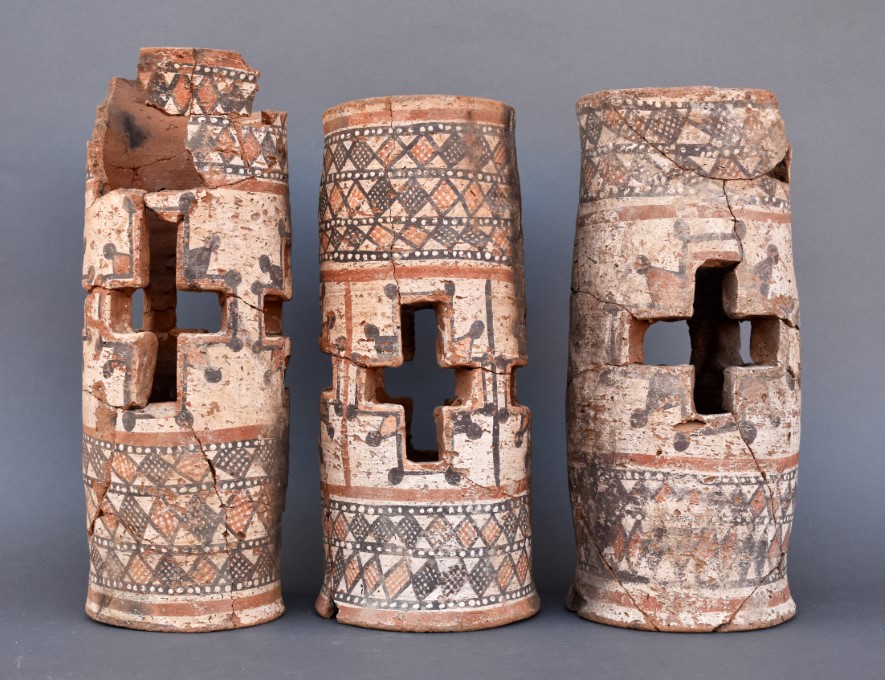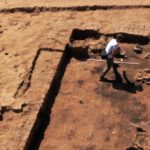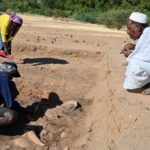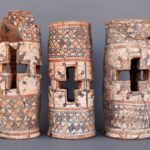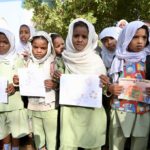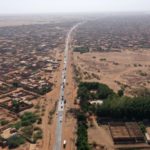Fieldwork in Soba, the former capital of the Kingdom of Alwa – today, a suburb of Khartoum – was paused for a mid-season break in mid-December. It was carried out by a team of specialists led by Dr. Mariusz Drzewiecki from the Polish Centre of Mediterranean Archaeology, University of Warsaw. Soba is one of the largest archaeological sites in Sudan. As the capital of the Christian kingdom of Alwa (from the 5th/6th centre to the 13th/14th century), it was described as a city with many churches, residences, beautiful gardens, and a district inhabited by Muslims.
Dr. Drzewiecki explains that archaeologists conducted excavations at two locations selected based on geophysical surveys conducted during the previous season. One of the trenches hit upon a storage and kitchen room that had been part of a larger architectural complex. The thick walls of this building protected the stored resources from the elements (Fig. 1). Along the inner walls of the warehouse, large ceramic storage vessels and various smaller containers for preparing and serving food were found (Fig. 2). In addition, small lamps (with visible signs of use), potstands, and lanterns were found (though the latter had no fire-related marks). In the corner of the room, there was a large, semicircular furnace.
The building was abandoned after being ravaged by fire. In the conflagration, the roof and parts of the walls collapsed breaking and burying the large storage vessels until they were discovered by archaeologists. Many of the discovered vessels are unique: they are unusually ornamented and in the future, they can become the highlight of many a museum exhibition (Fig. 3).
In the second trench, the remains of a medieval garden were discovered. It is the first such finding in Soba and one of just a few in all of Sudan. The remains included a fragment of an irrigation system that supplied water by a chanel to several trees or larger shrubs. Botanical samples were taken for analysis to determine what plant species were grown in this garden.
In addition to archaeological research, ethnological interviews were conducted with the residents of Soba. The people who currently live in the vicinity of the ruins are confronted with the remains of the past on a daily basis. No wonder that the local communities have developed rich folklore associated with the archaeological site. By studying it, researchers get acquainted with folk beliefs featuring supernatural entities, and stories from the lives of modern residents of Soba. This brings the researchers closer to the local community – and vice versa (Fig. 4) – and allows them to better understand each other.
Finding a common ground is important for securing a future for the remains of the former capital. The rapid pace of development in Khartoum makes undeveloped land on the outskirts of the city increasingly desirable (Photo 5). Protecting a site as large as Soba is, therefore, a growing challenge. For this reason, a cultural anthropologist working with the expedition conducted public consultations among various groups living in Soba, regarding their views on the future of the archaeological site, and whether there is room in it for the remnants of the distant past. These discussions produced the idea of creating a museum in Soba, which would display both ancient (archaeological) and modern (traditional) crafts and objects of everyday use.
The project „Soba – the heart of the kingdom of Alwa. The spatial organization of medieval capital city on the Blue Nile” is carried out by a scientific consortium of the Polish Centre of Mediterranean Archaeology, University of Warsaw (consortium leader) and the Institute of Archaeology and Ethnology of the Polish Academy of Sciences (consortium partner). The project is funded by a National Science Center grant number UMO-2018/29/B/HS3/02533.
Read more:
- About the project on the PCMA UW website.
- On the project website.
-
1. Documentation of the burnt storage and kitchen room at Soba / Prace dokumentacyjne w pozostałościach pomieszczenia magazynowo-kuchennego w Soba (fot. M. Drzewiecki)
-
2. Exploration of the fill of a storage and kitchen room / Eksploracja zasypu pomieszczenia magazynowo-kuchennego (fot. M. Kurcz)
-
3. Three lanterns found during this research season; many vessels from the storage-kitchen room have similar painted decorations / Trzy lampiony znalezione w tym sezonie badawczym; wiele naczyń z pomieszczenia magazynowo-kuchennego posiada podobne malowane zdobienia (fot. J. Ciesielska)
-
4. Children from elementary school in Soba with drawings of children from Cracow; cultural anthropologist, Maciej Kurcz, PhD, professor of Silesian University, mediates between children from schools in Poland and Sudan / Dzieci ze szkoły podstawowej w Soba z rysunkami dzieci z Krakowa; antropolog kulturowy, dr hab. Maciej Kurcz, prof. UŚ, pośredniczy w kontaktach między dziećmi ze szkół w Polsce i Sudanie (fot. M. Kurcz)
-
5. Bird’s eye view of Soba; intact fragments of buildings of the medieval town are to the right of the road / Widok Soba z lotu ptaka; nienaruszone fragmenty zabudowy dawnego miasta znajdują się na prawo od drogi asfaltowej (fot. M. Drzewiecki)

